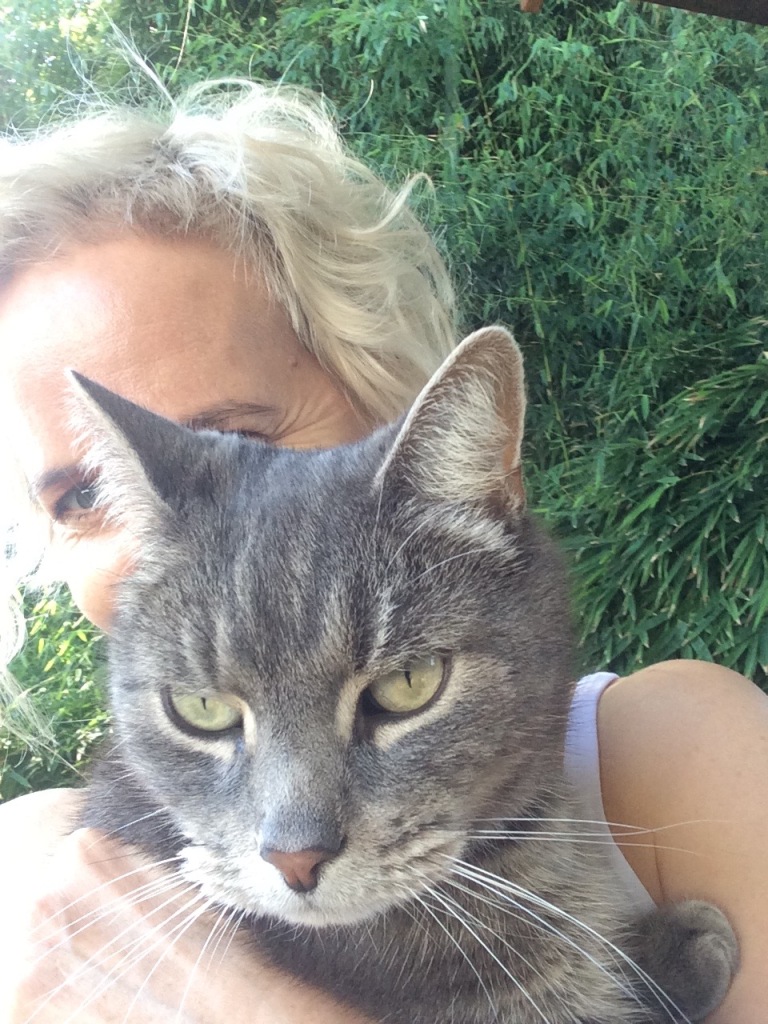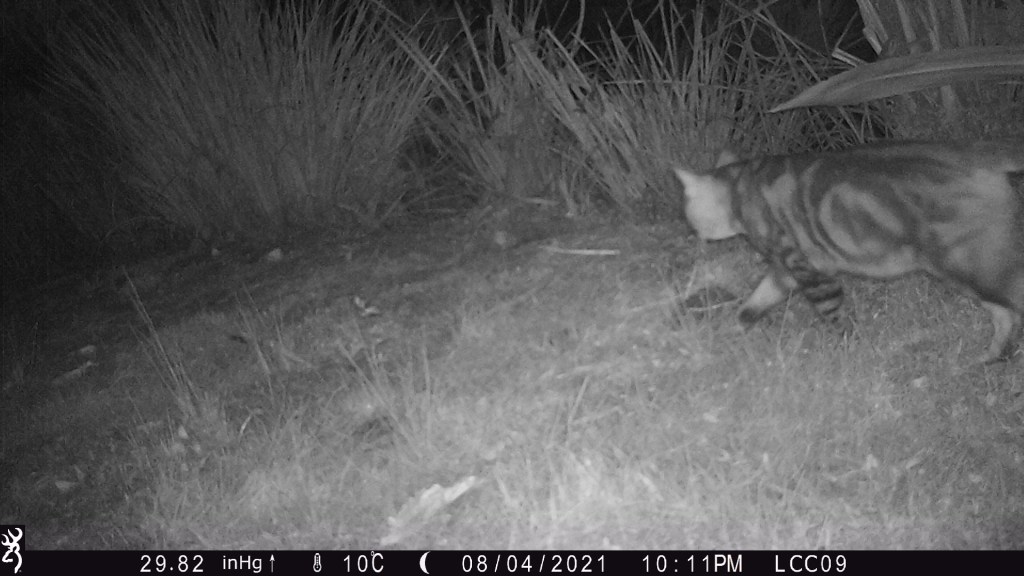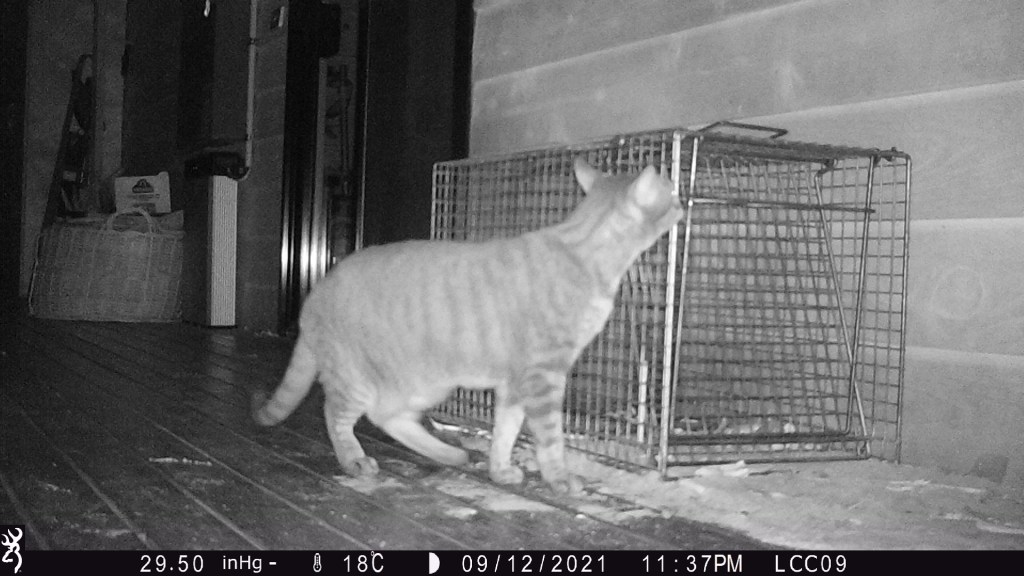It started innocently enough: I borrowed two 24-hr wildlife cameras, and set them up on my 2-acre rainforest retreat on the East coast of Australia.
Can you imagine my horror when amongst the cute snaps of pademelons, the lace monitor, wallaby mums with joeys in the pouch, and yes, a hurrying koala, I saw a big tabby cat?
I was shocked to say the least. Then the other camera revealed a second fat brindle cat, and even a fox!
My image of our property as a wildlife sanctuary crumbled.
Feral cats cover 99% of Australia, and are the Number One threat to our native wildlife (foxes are 2nd).
“On average, each feral cat in the bush kills a whopping 740 animals per year. In a year with average conditions there are about 2.8 million feral cats, but that figure can double when good rain leads to an abundance of prey animals.
“On average each pet cat kills about 75 animals per year, but many of these kills are never witnessed by their owners.” – Professor Sarah Legge from The Australian National University (ANU), Professor John Woinarski from Charles Darwin University, & Professor Chris Dickman from The University of Sydney: Cats in Australia: Companion and killer (2019).
I moved the cameras into different positions; daily checking of the footage gave me anxiety, as I realised both cats were regular visitors, and even walked up and down my verandah. Then a friend arriving for dinner one weekend announced she’d seen a third black cat at the top of my driveway- I nearly cried.

In outrage and despair, I rang my local Landcare group, and reached out to other community members who had cat trapping experience and advice. I borrowed a big cage, and the local trapper brought me another four: thus began my trapping mission.
(Don’t get me wrong: I LOVE domestic cats. Most of you know I’ve lived with the YetiCat for over 10 years. But he’s an inside cat, and that makes a HUGE difference).
Almost every night for a month, I did the rounds of setting traps, using the cameras to gather intel on what was happening in the dark of night; I caught a few rats, a bush turkey, and the resident echidna.
So annoying.
I had to watch in frustration as the cats sat in cage doorways but didn’t go in, or just ignored them altogether. Worst still was when the door had been triggered shut but they were outside.
The trapper kept saying “Be patient, you’ll get them…”
And he was right.
With persistence, I caught all three cats eventually!
Let me tell you: nothing is more satisfying than seeing a wild cat caught in a cage, knowing you’ve just saved hundreds of birds and small mammals. As I said, I love domestic cats kept indoors, but have hardened my heart to the feral versions, and the final big tomcat hissed and span circles in the trap, clawing madly and spraying everywhere to no avail. The trapper came to take them all away immediately, for the Big Sleep (after checking they weren’t microchipped lost pets).
Here are my Top Five Tips for feral cat-catching (not a blog post I ever thought I’d write):
- Use wildlife cameras to make smart decisions about where to place traps, plus who is visiting them and when
- Liaise with experienced community members, plus Landcare, and your local trapper
- Be persistent: I set my traps with bait every night at 8pm, and the big tom I was really after started appearing at 8.10. I also wore gloves, to prevent too much human smell, and oiled all the traps’ moving parts so the mechanisms were smooth
- Make the cage stable, and the floor as solid as possible: I caught all 3 cats in a small trap in the same place at the top of my driveway, using sand and leaves to camouflage the wire cage floor
- It’s all about bait: on advice, I used Dine cat food, KFC drumsticks, bloody lamb kidneys, and drops of smelly fish oil. They all worked eventually
Feel free to contact me for any further advice or inspiration, and my family now proudly call me ‘Trapper G’, which is a very unexpected outcome of my move to a hippy forest idyll…
Now for the fox hey?
In gratitude for determination, a small killer instinct, & fish oil, G xO







Congratulations and job well done! We do our best to keep neighborhood cats, feral and owned, out of our garden, but it’s a very different culture here, and even some of those who claim to be on the side of wildlife also advocate for free-range introduced predators… err… cats. We need to follow Australia and New Zealand’s example. Are foxes introduced there?
LikeLiked by 2 people
Well done for trying at least! Yes, foxes are an absolute introduced feral nightmare… rabbits too… Australia has a terrible colonial history of decimating the wildlife
LikeLike
Horrific stats on pet kills. Feral cats are a big problem. Great post to educate and inform and well done removing three of them. There may be more….
LikeLiked by 2 people
Thanks- yes, I’m pretty chuffed to have got 3, but also admit I may have to keep trapping and see if I get more 😦
LikeLiked by 1 person
‘Tis a harsh thing to end a life, but what we humans have created, we must also bear the responsibility for the consequences.
LikeLiked by 2 people
Absolutely. Same with cane toads… humans are so dumb/careless/destructive
LikeLiked by 1 person
You did the right thing, I believe. And thanks for giving the tips for others. Sadly, here in the States “Trap, Spay and Release” is a popular movement. They catch the cats, spay or neuter them, and then turn them loose. For one thing, feral and stray cats live very tough (and usually very short) lives. But the damage they do to wildlife is real, and needs to be addressed.
LikeLiked by 2 people
I can’t believe it is such a popular movement! I came across it when researching how to trap ferals- poor cats, thrown back out to fend for themselves. And what do people think they eat?? Thanks for your support Ann
LikeLiked by 1 person
Anything that can claim “no kill” is wildly popular here, mostly because people don’t understand the consequences. Feral and stray cats suffer before they die, so we’re not doing them any favors by not choosing euthanasia for them. (Although if a home for stray cat can be found, that’s great!) It’s the same with shelters…the “no kill”ones fill up and stop accepting new animals, so those animals are just turned loose to fend for themselves, or listed for free on the internet. And trust me, you don’t want to know what happens to most of those poor animals.
LikeLiked by 1 person
I am a big fan of euthanasia in general…
LikeLiked by 1 person
Well done! What a horrible discovery. I’m an avid cat lover but mine have a fully enclosed back garden (cat cage including roof) and a second smaller cat pen plus inside my house to chase each other and sleep all day! I hope your cameras don’t reveal more usurpers!
LikeLiked by 2 people
Horrible indeed. I’d love a cat in an enclosure: I’d make it the most interesting cat pen ever! Well done for keeping them in- I so love cats- nothing more on cameras yet… xx ❤
LikeLike
It’s fascinating what you found on your nature cam at night! 🙂 Good job catching the cats. I had no idea that they were such lethal killers. Our kitties never go outside. Indoor only divas LOL
LikeLiked by 2 people
Indoor divas is perfect! 🙂
Perhaps cats aren’t such a problem in the UK?
Love my wildlife cams 🙂
LikeLike
I love your wildlife cams too! Keep showing us what you find out there in the middle of the night…it’s wild and wonderful to see! Where I am, it’s not a problem, but then who knows what goes on at night. I don’t have a night camera to see!
LikeLiked by 1 person